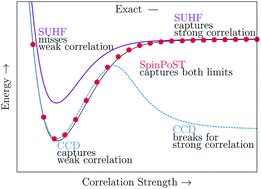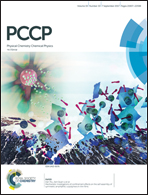Spin polynomial similarity transformation for repulsive Hamiltonians: interpolating between coupled cluster and spin-projected unrestricted Hartree–Fock
Abstract
Our overarching goal is to be able to describe both weak and strong correlation with a single, computationally affordable method without sacrificing important qualities of the wavefunction, e.g. symmetries of the Hamiltonian. We know that coupled cluster theory with low-order excitations is excellent at describing weakly-correlated systems near equilibrium, but breaks down as systems become more strongly correlated. Projected Hartree–Fock on the other hand is inherently capable of describing multireference character, but misses weak correlation. We are thus exploring how best to combine coupled cluster and projected Hartree–Fock in our search for a computationally feasible method that is applicable across a wide range of correlation strengths. In this manuscript, we adapt our earlier work on the pairing Hamiltonian to repulsive Hamiltonians, resulting in the spin polynomial similarity transformation (SpinPoST) interpolation. SpinPoST parameterizes the wavefunction in order to interpolate between the coupled cluster and spin-projected unrestricted Hartree–Fock ansätze self consistently, and is a spin-symmetry adapted model which involves only single and double excitations. We employ a unique approach of optimizing the wavefunction by minimizing the effect of connected quadruple excitations, resulting in a method which is spin-symmetry adapted and is comparable energetically to coupled cluster with singles and doubles for weak correlation and spin-projected Hartree–Fock for strong correlation.



 Please wait while we load your content...
Please wait while we load your content...